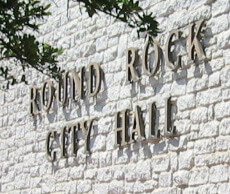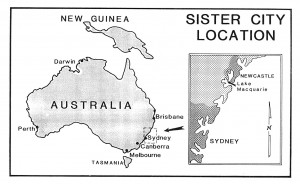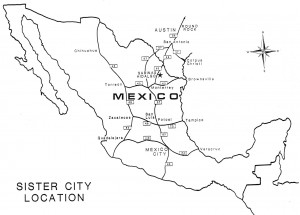The Historic Round Rock Collection
Political Structure
The Historic Round Rock Collection is a project documenting Round Rock’s history, funded in part with a grant from the Texas Historical Commission. These pages are adapted from the original 1991 print version; later additions have been made by staff. Recent Round Rock news is given in the News feature.
Incorporation
 Round Rock was officially incorporated in 1913 and started holding regular City Council meetings in January of that same year (Community Data Book 9). Today, Round Rock operates as a home-rule city with a council-manager form of government. The Texas home-rule law allows any city with a population of more than 5,000 to write its own constitutions, known as city charters. To become effective, the city charter must be approved by a majority vote of the citizens. The citizens of Round Rock passed their most recent charter in 1977. A home-rule city may choose any type of organizational structure as long as it conforms with state laws and the state constitution (Kraemer and Newell 141). The council-manager form of government allows for the election of city council members, either at-large or by districts. The mayor is also elected at large and is a member of the council and presides over it but has the same powers as any other council member. The council then appoints a city manager who is responsible for the hiring and firing of the City’s department heads and for the preparation of the budget. The intent of this form of government is to separate politics from administration (Ibid. 143). In Round Rock, there are six Council Members and a Mayor, all of whom are elected at large (Community Data Book 15).
Round Rock was officially incorporated in 1913 and started holding regular City Council meetings in January of that same year (Community Data Book 9). Today, Round Rock operates as a home-rule city with a council-manager form of government. The Texas home-rule law allows any city with a population of more than 5,000 to write its own constitutions, known as city charters. To become effective, the city charter must be approved by a majority vote of the citizens. The citizens of Round Rock passed their most recent charter in 1977. A home-rule city may choose any type of organizational structure as long as it conforms with state laws and the state constitution (Kraemer and Newell 141). The council-manager form of government allows for the election of city council members, either at-large or by districts. The mayor is also elected at large and is a member of the council and presides over it but has the same powers as any other council member. The council then appoints a city manager who is responsible for the hiring and firing of the City’s department heads and for the preparation of the budget. The intent of this form of government is to separate politics from administration (Ibid. 143). In Round Rock, there are six Council Members and a Mayor, all of whom are elected at large (Community Data Book 15).
And then the water ran out...
In 1978, the Central Texas area was in the midst of a severe drought, preventing the Edwards Underground Aquifer from being adequately recharged. At this time, Round Rock was totally dependent on the aquifer for its water needs; when the groundwater wells went dry, the City was left without a source of fresh water.
The political fallout from the sudden lack of water forced the City Council and the City administration to procure a reliable supply of water. The drilling of a new deeper well was considered, but the City decided that the amount of water available from a new well would be insufficient for future growth. In order to ensure that growth would not be limited by the water supply, the City obtained surface water rights from Lake Georgetown. By 1981, the City had constructed a water treatment plant capable of processing six million gallons of water per day. The plant is fed by a 30 inch, nine-mile-long pipeline from Lake Georgetown. The City’s water supplies will also be guaranteed by the future authorization to use water from the Brazos River Authority.
Sufficient water supplies, coupled with the construction of infrastructure and amenities, opened Round Rock for the brisk new development that soon followed. The guarantee of fresh water catapulted Round Rock into the position of Austin’s most important suburb.
Sister City Program
In order to establish relations and foster goodwill among international cities, Round Rock joined the Sister City Program. The Program allows cities of similar sizes and characteristics to exchange employees for short periods of time. These exchanges allow the individuals involved to gain insights into how cities in foreign countries have dealt with problems. The intent is that the exchange program will benefit the two cities by providing their employees with increased understanding of the challenges facing cities in the global community, which will then help them to deal with the problems facing their own cities.
In 1985, Round Rock established a sister city relationship with the City of Lake Macquarie, Australia. Since that time, there have been regular visits between officials of the two cities and several exchanges among administrative professionals. In 1991, Round Rock also established a sister city relationship with the City of Sabinas Hidalgo, Nuevo Leon, Mexico.
 |  |
Works Cited
Kraemer, Richard H. and Charldean Newell. Essentials of Texas Politics (second edition). New York: West Publishing Company. 1983.
Round Rock Texas Community Data Book (second edition). City of Round Rock Department of Planning & Community Development. 1986.
Round Rock the “Quality of Life” Capital of Texas. City of Round Rock Department of Planning & Community Development. 1990.


